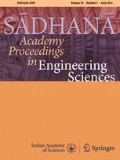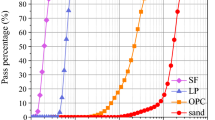Abstract
This research study presents the mechanical behaviour of new hybrid fiber reinforced engineered cementitious composite. Uniaxial compressive, four-point bending, direct tensile test, non-destructive testing and scanning electron microscopy of materials were performed to characterize the behaviour of new hybrid reinforced ECC. The replacement of polyvinyl alcohol (PVA) fiber with polyester (PET) fiber showed that the increment of PET fiber percentage in cement matrix enhanced the tensile strain and mid-point deflection; whereas, decreased the strength properties. Amalgam of three type of fibers at percentage level 1, 0.5 and 0.5 respectively in cementitious material increased the strength parameters; while, tensile strain and deflection decreased. Recorded ultrasonic pulse velocity values exhibited that the combined dispersion of polymeric and non-polymeric fibers do not affect the quality of concrete. Mechanical behaviour of different ECC matrices demonstrated that the dispersion of low modulus fiber enhanced the mid span deflection and tensile strain capacity; however, the inclusion of high modulus fiber improved the ability of matrix to sustain higher loadings. Hybridization of fibers cut the total cost of the cementitious matrix which promotes the use of ECC at large scale.











Similar content being viewed by others
Abbreviations
- ECC:
-
Engineered cementitious composite
- GGBFS:
-
Ground granulated blast furnace slag
- SS:
-
Silica sand
- PVA:
-
Polyvinyl alcohol fiber
- PET:
-
Polyester fiber
- MSE:
-
Micro steel fiber
- UPV:
-
Ultrasonic pulse velocity
- PCE:
-
Polycarboxylic ether
- PE:
-
Polyethylene
References
Li V C and Kanda T 1998 Engineered cementitious composites for structural applications. J. Mater. Civ. Eng. 10: 66–69
Singh M, Saini B and Chalak H D 2020 Long term evaluation of engineered cementitious composite containing stone slurry powder. Constr. Build. Mater. 264: 120183
Redon C, Li V C, Wu C, Ogawa A, Hoshiro H and Saito T 2001 Measuring and modifying interface properties of PVA fibers in ECC matrix. J. Mater. Civ. Eng. 13: 399–406
Singh M, Saini B and Chalak H D 2019 Performance and composition analysis of engineered cementitious composite (ECC) – A review. J. Build. Eng. 26: 100851
Kanda T and Li V C 1998 Interface property and apparent strength of high-strength hydrophilic fiber in cement matrix. J. Mater. Civ. Eng. 10: 5–13
Singh M, Saini B and Chalak H D 2019 Properties of engineered cementitious composites: A Review. In: Proceedings of the 1st International Conference on Sustainable Waste Management through, 473-483. GNDEC, Ludhiana: India
Meng D, Huang T, Zhang Y X and Lee C K 2017 Mechanical behaviour of a polyvinyl alcohol fibre reinforced engineered cementitious composite (PVA-ECC) using local ingredients. Constr. Build. Mater. 141: 259–270
Li Junxia and Yang E H 2017 Macroscopic and micro structural properties of engineered cementitious composites incorporating recycled concrete fines. Cem. Concr. Compos. 78: 33–42
Huang T and Zhang Y X 2014 Mechanical properties of a PVA fiber reinforced engineered cementitious composites. Sustainable Solutions in Structural Engineering and Construction. 439-444
Huang X, Ranade R and Li V C 2013 Feasibility study of developing green ECC using iron ore tailings powder as cement replacement. J. Mater. Civ. Eng. 25: 923–931
Altwair N M, Johari M A M and Hashim S F S 2012 Flexural performance of green engineered cementitious composites containing high volume of palm oil fuel ash. Constr. Build. Mater. 37: 518–525
Huang X, Ranade R, Ni W and Li V C 2013 On the use of recycled tire rubber to develop low E-modulus ECC for durable concrete repairs. Constr. Build. Mater. 46: 134–141
Rathod J D and Patodi S C 2010 Interface tailoring of polyester-type fiber in engineered cementitious composite matrix against pullout. ACI Mater. J. 107: 114–122
Singh S B, Munjal P and Thammishetti N 2015 Strengthening of masonry beam with ECC as bed joint. J. Eng. Sci. Technol. 8: 29–39
Singh M, Saini B and Chalak H D 2019 Appraisal of Hybrid Fiber Reinforced Engineered Cementitious Composite. In: Proceedings of the 4th International Conference on Civil, Structural and Transportation Engineering (ICCSTE'19). Carleton University, Ottawa: Canada
Ahamed A, Sunitha S, Vinod P and Bindhu K R 2012 A comparative study on the flexural behaviour of RCC and R/ECC beams. International conference on green technologies (ICGT), IEEE, Trivandrum, Kerala, India
Alrefaei Y, Khaldoun R and Maalej M 2018 Shear strength of beams made using hybrid fiber–engineered cementitious composites. J. Struct. Eng. 144: 04017177
Ali M A E M, Soliman A M and Nehdi M L 2017 Hybrid-fiber reinforced engineered cementitious composite under tensile and impact loading. Mater. Des. 117: 139–149
Pakravan H R, Jamshidi M and Latifi M 2015 The effect of hybridization and geometry of polypropylene fibers on engineered cementitious composites reinforced by polyvinyl alcohol fibers. J. Compos. Mater. 50: 1007–1020
Pakravan H R, Jamshidi M and Latifi M 2016 Study on fiber hybridization effect of engineered cementitious composite with low and high-modulus polymeric fibers. Constr. Build. Mater. 112: 739–746
Yang H, Li J and Huang Y 2016 Study on mechanical properties and constitutive equation of hybrid fiber reinforced cementitious composites under static loading. The Open Constr. Build. Mater. J. 10: 482–491
Soe K T, Zhang Y X and Zhang L C 2013 Impact resistance of hybrid-fiber engineered cementitious composite. Compos. Struct. 104: 320–330
Ahmed S F U, Maalej M and Paramasivam P 2003 Strain hardening behaviour of fiber reinforced cement composites. J. Ferrocem. 33: 172–182
Pan Z, Wu C, Liu J, Wang W and Liu J 2015 Study on mechanical properties of cost-effective polyvinyl alcohol engineered cementitious composites (PVA-ECC). Constr. Build. Mater. 78: 397–404
Ahmed S F U and Mihashi H 2010 Corrosion durability of strain hardening fiber reinforced cementitious composites. Aust. J. Civ. Eng. 8: 13–26
Mobasher B and Li C Y 1996 Mechanical properties of hybrid cement-based composites, ACI Mater. J. 93: 284-292
Zhang J, Maalej M and Quek S T 2007 Performance of hybrid-fiber ECC blast/shelter panels subjected to drop weight impact. J. Mater. Civ. Eng. 19: 855–863
Soe K T, Zhang Y X and Zhang L C 2013 Material properties of a new hybrid fibre-reinforced engineered cementitious composite. Constr. Build. Mater. 43: 399–407
Kawamata A, Mihashi H and Fukuyama H 2003 Properties of hybrid fiber reinforced cement-based composites. J. Adv. Concr. Technol. 1: 283–290.
Lawler J S, Zampini D and Shah S P 2005 Microfiber and macro fiber hybrid fiber-reinforced concrete. J. Mater. Civ. Eng. 17: 595–604
Maalej M, Quek S T and Zhang J 2005 Behavior of hybrid-fiber engineered cementitious composites subjected to dynamic tensile loading and projectile impact. J. Mater. Civ. Eng. 17: 143–152
IS-8112-2013. Specification for 43 grade ordinary Portland cement. Bureau of Indian Standards, New Delhi
ASTM C150-2016. Standard Specification for Portland cement. ASTM International, West Conshohocken, PA
Yang E H, Sahmaran M, Yang Y and Li V C 2009 Rheological control in production of engineered cementitious composites. ACI Mater. J. 106: 357–366
Ferraris C F, Obla K H and Hill R 2001 The influence of mineral admixtures on the rheology of cement paste and concrete. Cem. Concr. Compos. 31: 245–255.
IS 516-1959. Methods of tests for strength of concrete (18th ed.). Bureau of Indian Standards, New Delhi
ASTM C1611-2014 Standard test method for slump flow of self-consolidating concrete. American society for testing and materials, West Conshohocken, PA, USA
BS-EN-12390-3-2009 Testing hardened concrete, Compressive strength of test specimens. British Standard Institution
BS-EN-12390-5-2009 Testing hardened concrete, Flexural strength of test specimens. British Standard Institution
IS 13311(Part 1)-1992 Code of practice for Non-Destructive Testing of concrete- Methods of test part: 1 Ultrasonic pulse test. Bureau of Indian standards (BIS), New Delhi. (Reaffirmed 2004)
ASTM C597-2016 Standard Test method for pulse velocity through concrete. ASTM International, West Conshohocken, PA
Li V C 2007 Engineered Cementitious Composites (ECC) – Material, structural, and durability performance, Book Chapter in Concrete Construction Engineering Handbook, Ed. E. Nawy to be published by CRC Press
Acknowledgement
The authors thank the University Grants Commission (UGC), New Delhi for the financial assistance for research work. And also, thank to Kuraray India Limited and Reliance India Limited for providing fibers.
Author information
Authors and Affiliations
Corresponding author
Rights and permissions
About this article
Cite this article
Singh, M., Saini, B. & Chalak, H. Evaluation of cost-effective hybrid fiber reinforced ECC. Sādhanā 46, 109 (2021). https://doi.org/10.1007/s12046-021-01637-w
Received:
Revised:
Accepted:
Published:
DOI: https://doi.org/10.1007/s12046-021-01637-w




